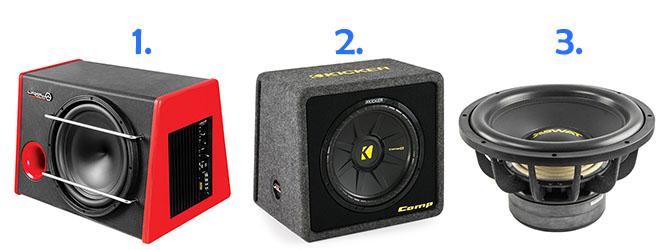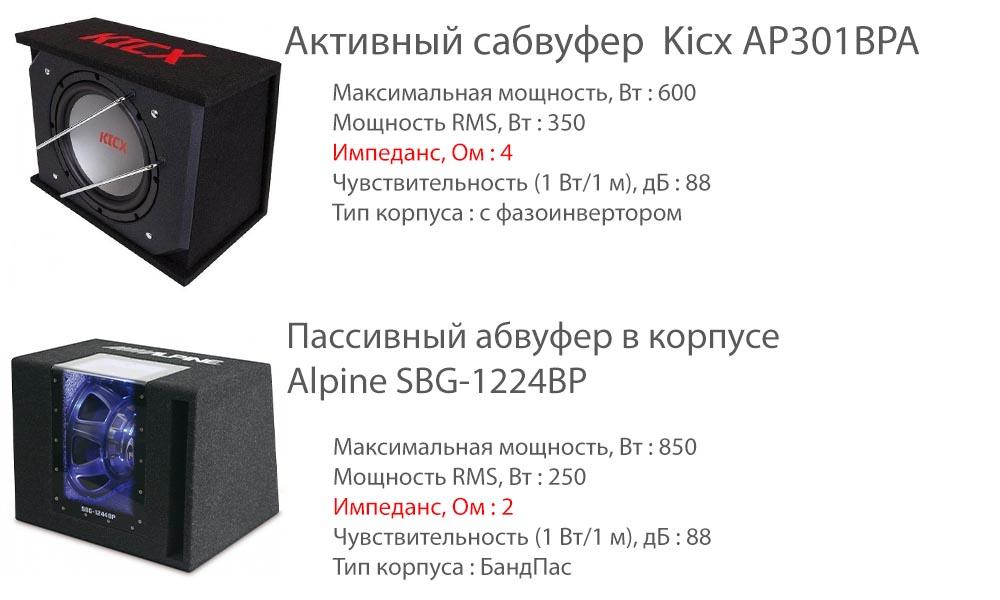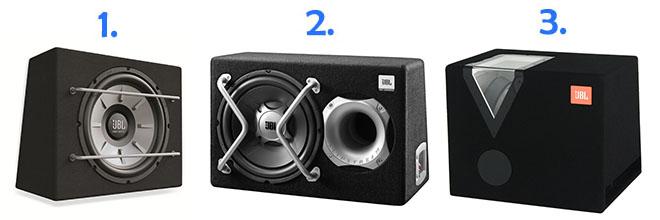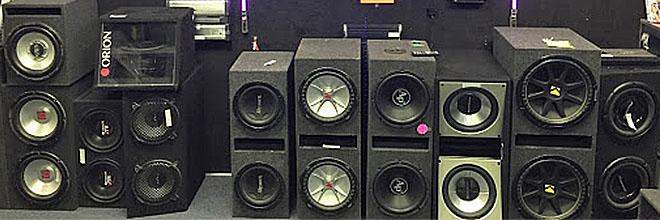
How to make the right choice when buying a subwoofer, analyze the characteristics and other criteria
Content
Visiting a car audio store, you can fall into a stupor, from the presence of various types of subwoofers. This article will answer the question of how to choose a subwoofer in a car, what characteristics you should pay attention to and which ones are better to ignore, consider the types of boxes and their sound in various car bodies.
There are 3 options for subwoofers:
- Active;
- Passive;
- An option when a separate speaker is purchased, a box is made under it, an amplifier and wires are bought. Since this option implies a more complex and expensive process, there is a separate article for it, a link to it, and we placed our opinion at the end of the article. But first, we advise you to read this article, in it we examined the basic indicators that will be useful to you when choosing a subwoofer speaker, in the next article we will not return to them, but will delve into more complex characteristics.

The article is perfect for novice car audio lovers who want to add bass to their car for little money.
Types of subwoofers, active and passive
As already mentioned, we will consider 2 options: one is simpler, the other is a little more complicated, but more interesting.
1st option ─ active subwoofer. Everything is already included with it, a box to which the amplifier is screwed and all the necessary wires for connection. After the purchase, all that remains is to go to the garage or service center to install it.
2nd option ─ passive subwoofer. Here everything is a little more complicated. You only get the speaker and box. The manufacturer made a calculation, assembled the box and screwed the speaker to it. You choose the amplifier and wires yourself.
In comparison, an active subwoofer is a more budget solution, and the result will be appropriate, you should not expect anything more from it.
Passive subwoofer ─ the step is already higher.
We will not dwell on this section for a long time, for more detailed information, check out the article comparing an active and passive subwoofer.
It is also worth noting that, in modern realities, we do not recommend passive subwoofers in the factory box. We advise you to overpay a little and purchase a subwoofer speaker and a separate box. The bundle will turn out a little more expensive, but the result will surprise you.
What characteristics should you pay attention to when choosing a subwoofer?
Often, manufacturers try to show that their product is better than it actually is. They can write some unrealistic numbers on the box. But, looking at the instructions, we find that there are not so many characteristics, as a rule, because there is nothing special to brag about. However, even with this small list, we will be able to make the right choice.
Power
Now, when choosing a subwoofer, the main preference is given to power, it is believed that the more powerful the equipment, the better. In fact, this is not entirely true. Let's figure out how much power you should pay attention to.

Peak (MAX)
As a rule, the manufacturer likes to indicate it everywhere, and these are some unrealistic numbers. For example, 1000 or 2000 watts, moreover, for little money. But, to put it mildly, this is a scam. That kind of power isn't even close. Peak power is the power at which the speaker will play, but only for a short time. In this case, there will be a terrifying sound distortion. Unfortunately, in this mode, the task of the subwoofer is not high-quality sound ─ but just to survive a couple of seconds.
Rated (RMS)
The next power that we will consider, ─ nominal power in the instructions can be referred to as RMS. This is the power at which sound distortion is minimal, and the speaker can play for a long time without harming itself, it is to it that you should pay attention. No matter how strange it may sound, but, for example, when comparing a powerful and weak subwoofer, a weak one can play louder than a powerful one. That is why power is not the main indicator. It shows how much power the speaker is using, not how loud it plays.
If you are going to purchase a passive subwoofer, its volume and sound quality will directly depend on whether you have chosen the right amplifier for it. To avoid the situation when a subwoofer was bought and because of an unsuitable amplifier it does not play, we advise you to read the article “How to choose an amplifier for a subwoofer“
Sensitivity
Sensitivity is the ratio of the diffuser area to its stroke. In order for a speaker to play loudly, it needs a large cone and a large stroke. But often manufacturers make a huge suspension, an impressive lip. People think that the speaker has a big stroke, and it plays louder, but in fact it loses to speakers with a large cone. You should not give preference to subwoofers with a large lip, it loses to a small one, because a speaker with a large cone has a higher efficiency. Thus, a large stroke is beautiful, but the diffuser area is much more useful.
This indicator is measured in the following way. They take a speaker, put a microphone at a distance of one meter and apply 1 watt strictly to the speaker. The microphone captures these readings, for example, for a subwoofer it can be 88 Db. If power is consumption, then sensitivity is the return of the subwoofer itself. By increasing the power by 2 times, the sensitivity will increase by 3 decibels, a difference of 3 decibels is considered to be a 2-fold increase in volume.

Now you understand that power is not the main indicator. Let's take an example, the first subwoofer has a rated power of 300 watts and a sensitivity of 85 decibels. The second one also has 300 watts and a sensitivity of 90 decibels. 260 watts were applied to the first speaker, and 260 watts to the second, but the second speaker will play an order of magnitude louder due to greater efficiency.
Resistance (impedance)

Basically, all car cabinet subwoofers have an impedance of 4 ohms. But there are exceptions, for example, 1 or 2 ohms. The resistance affects how much power the amplifier will give, the lower the resistance, the more power the amplifier gives. Everything seems to be fine, but in this case it starts to distort the sound more and warm up more.
We recommend choosing a resistance of 4 ohms ─ this is the golden mean between quality and loudness. If the active subwoofer has a small resistance of 1 or 2 ohms, then most likely the manufacturer is trying to squeeze the maximum out of the amplifier, not paying any attention to sound quality. This rule does not work in loud systems, and in sound pressure competitions. These subwoofers have two coils, thanks to which you can change the resistance and switch to a lower one, which will allow you to get maximum volume.
Speaker size
The next thing we can look at when we come to the store is the size of the subwoofer, most speakers have a diameter:
- 8 inches (20cm)
- 10 inches (25 cm);
- 12 inches (30 cm);
- 15 inches (38 cm);
The most common is considered to be a diameter of 12 inches, so to speak, the golden mean. The advantages of a small speaker include its fast bass speed, and a small box volume that will help save space in the trunk. But there are also disadvantages ─ it is difficult for him to play lower bass. It has lower sensitivity, hence it is quieter. The table below shows how the characteristics change depending on the size.

| Features | 8 inch (20 cm) | 10 inch (25 cm) | 12 inch (30 cm) |
|---|---|---|---|
| RMS power | 80 W | 101 W | 121 watts |
| Sensitivity (1W/1m) | 87 db | 88 db | 90 db |
Here we can build on your musical preferences. Let's say you like different kinds of music. In this case, it is better to consider the 12th subwoofer. If you don't have much trunk space and you only listen to club music, then the 10-inch size is worth considering. If you prefer, for example, rap or music where there is a lot of bass, and the trunk allows you, then it is better to opt for a 15-inch subwoofer ─ it will have the highest sensitivity.
Box type (acoustic design)
The next thing we can visually determine how a subwoofer will play is to look at the type of box and determine what material it is made of. The most common boxes that you can find in the store:
- Closed box (ZYa);
- space inventory (FI);
- Bandpass (BP)

- Consider the advantages of a closed box. It has the most compact size, fast and clear bass, minimal sound delays. Of the minuses - the quietest design. Now we will discuss the installation of a subwoofer in various car bodies. If you are the owner of a station wagon, hatchback, you can install 10, 12, 15 inches without a difference. If you have a sedan, then it is not recommended to install a 10-inch in a closed box, you will just hear it. The efficiency of the box is very small, 10 plays quietly, and in total nothing interesting will come of it.
- The next option, which is often found, is a phase inverter. This is a box that has a slot or hole. It plays 2 times louder than a closed box and has an order of magnitude larger dimensions. However, in fact, the sound quality is no longer so clear, it is more buzzing. Nevertheless, this is the best option and is suitable for absolutely any car body. Thus, the phase inverter is loud, its delays are within the normal range, a kind of golden mean.
- Bandpass is a design in which the speaker is hidden in a box. Usually it is decorated with some beautiful plexiglass. In size, it is the same as a phase inverter, but at the same time it has the greatest return. If you need to squeeze the maximum out of the speaker, then it is better to purchase a bandpass. However, it also has its drawbacks, namely, the slowest design. It is difficult for this speaker to play fast club music, it will be late.
For those who want to delve deeper into the comparison of boxes, namely displacement, port area, and other indicators, read this article on how the box affects the sound.
Listening to a subwoofer
The next thing to do when choosing a subwoofer is to listen to it. This section can hardly be called objective, because. the sound in the room and the car will be different. In this regard, not all sellers want to connect subwoofers and demonstrate how they play.
The main goal in this section is the following, you have chosen a couple of options according to the characteristics. If you connect them and compare them in any case, the sound and volume will be different for them, and you will make a choice that you like.

Listening tips:
- It is not necessary to ask the consultant to connect each subwoofer. Choose 2 options for comparison based on the recommendations we gave above;
- Try to compare on different genres, where there is a higher bass and lower, fast and slow. The ideal option for comparison would be the music tracks that you listen to most often.
- Choose one listening point, in a room, the sound in different parts of the room can be very different.
- Remember that the subwoofer tends to play out. After a while, its volume will increase and the bass will become clearer and faster.
- Can't you hear the difference? Make a choice in favor of a cheaper option 🙂
These rules only work for boxed subwoofers. Comparing subwoofer speakers does not make any sense.
Summing up
In today's world, cabinet subwoofers have lost their value. There are better options on the market. With a little effort and a little more money, we will get a result 2 or even 3 times better. And this option is called buying a subwoofer speaker. Yes, you will need to do a little more action, but the result will exceed all your expectations, we advise you to read the article “How to choose a subwoofer speaker”, the information in it will also be useful to those who want to purchase a cabinet subwoofer.
Arriving at the store first, what is worth paying attention to, which subwoofer do we choose passive or active?
- In this section, we recommend giving preference to a more active subwoofer, the reason is as follows. A passive subwoofer in a factory box and all the necessary additions to it in the form of an amplifier and wires come out not so cheap. By adding some money, let's say +25%, we can easily move to the next step. Buy separately the speaker, the correct amplifier box and wires, and this bundle will play 100% more interesting.
Secondwhat we pay attention to
- ratio of rated power (RMS) and sensitivity. We choose power and sensitivity according to the principle “the more the better”. If the subwoofer has a lot of power and low sensitivity, then it is better to opt for one with a higher sensitivity, even if it is a little weaker.
The third as for speaker size
- If the trunk is not particularly needed, choose a larger subwoofer diameter. If you listen to club music, then it is better to make a choice in favor of 10 or 12 inches.
Fourth about the body
- if sound quality, clarity and detail are important, - a closed box, in order to level its main drawback - a quiet sound, we recommend installing it in cars in which the trunk is equal to the passenger compartment, these are cars with a station wagon hatchback and jeep.
- In most cases, we recommend the structure of the box - a phase inverter. This is the golden mean in terms of volume, quality and bass speed. It’s not without reason that when you come to the store, this type of box will be the most common.
- If you want maximum volume for little money, this is a bandpass, although it is used extremely rarely.
Fifth hear with ears
- And finally, listen to a couple of options for subwoofers in the room, this point is doubtful, but in any case, after that all doubts will be dispelled, and you will take your subwoofer away with the thoughts that you made the right choice.
Conclusion
We have put a lot of effort into creating this article, trying to write it in a simple and understandable language. But it is up to you to decide if we did it or not. If you still have questions, create a topic on the "Forum", we and our friendly community will discuss all the details and find the best answer to it.
And finally, do you want to help the project? Subscribe to our Facebook community.
